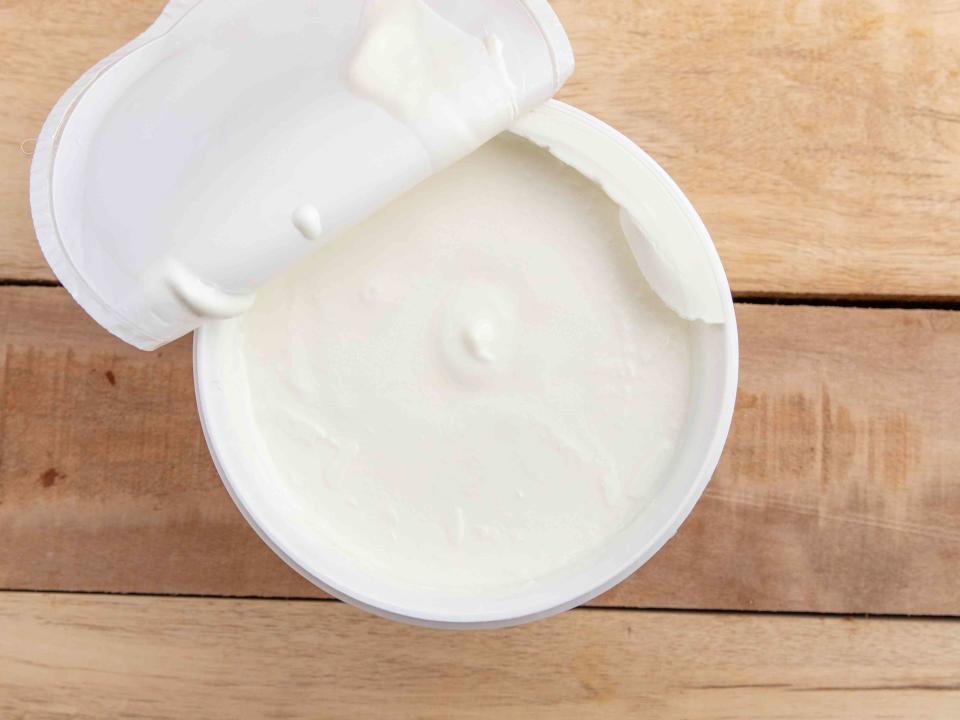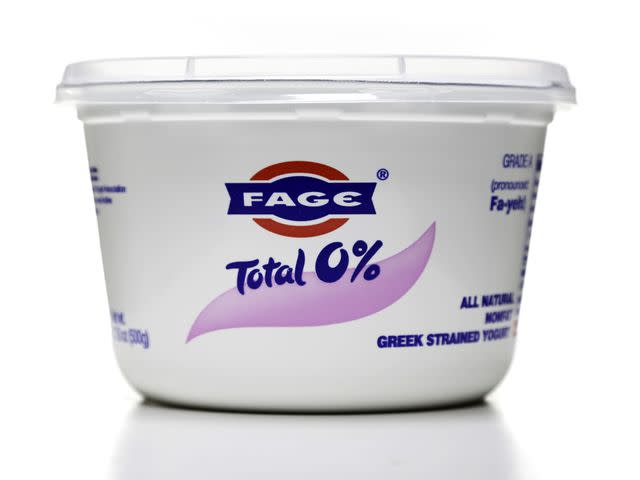Why Does Greek Yogurt Sometimes Have Paper On Top?
Believe it or not, the soggy, waterlogged round of paper atop your favorite tub of Greek yogurt has a very specific purpose.

annick vanderschelden photography/Getty Images
Greek yogurt has become an incredibly popular choice over traditional yogurt for its tangy flavor, creamy texture, and high protein content. With its rise in favor, more and more food producers have released their own version. If you're a Greek yogurt connoisseur, you know that not all store-bought Greek yogurt is the same. For example, you may have encountered the perplexing soggy round of paper atop your favorite brand and wondered what the heck it's there for.
What Is Greek Yogurt?
If you've tried both, you know the most significant difference between Greek and “regular” yogurt is the texture. Greek yogurt is very thick and dense, much different than the runnier texture of most regular yogurt brands. This is because Greek yogurt is strained — meaning, much of the liquid is drained out of it. You can actually make Greek-style yogurt from regular yogurt by straining it through cheesecloth for several hours. If you've ever had Labneh, it's made through a similar process; however, it is even more strained than Greek yogurt, leaving very little liquid. And while that liquid may just look like yogurt-y water, it's actually a byproduct called whey.
Related: 19 Smart Ways to Use Plain Greek Yogurt
What Is Whey?
You may know of whey from protein bars or smoothie add-ins, but it's also an integral part of yogurt composition. Whey is the byproduct of the fermentation process that turns milk into yogurt. Whey is one of the main proteins found in milk and is carried in liquid form in yogurt- and cheese-making. In regular yogurt, there's lots of whey, and it's usually dispersed throughout. The more the yogurt is strained, the less whey there is, and it tends to collect on the surface versus dispersing through the dense, strained yogurt.
What Does the Paper on Top of the Yogurt Do?
If you've ever opened a container of Greek yogurt without the paper, you may have noticed a layer of that liquid whey. Some people pour it off, and some people mix it. Greek yogurt is known for its thick texture, so mixing it in can change the texture and flavor because whey is very acidic and will thin out Greek yogurt. Of course, pouring it off can be tricky, as you run the risk of accidentally dumping your entire container of yogurt into the sink. To combat this, some brands (like Fage) include a layer of paper to help absorb the whey. If you've ever used a paper towel to blot the grease from a slice of pepperoni pizza, it's the same general idea. This way, the yogurt maintains the texture that the manufacturer intends it to have, and the customer isn't responsible for dealing with the whey.

jfmdesign/Getty Images
Why Don't All Yogurts Have It?
Some brands seemingly don't consider the whey an issue; it is, after all, a very normal part of yogurt production. Others add elements like emulsifiers, gelling agents, and gums to keep the whey from separating. The trade-off here is that while you don't encounter that separation, the flavor and texture can be impacted. Brands that use fewer ingredients or bill themselves as more "natural" usually don't include these types of stabilizing ingredients, so be prepared for a bit of whey accumulation on the surface of your yogurt.
Should I Throw the Paper Away or Leave It In?
By the time your new tub of yogurt gets to you, and you peel the foil off, that little piece of soggy paper has done most of the work it's ever going to do. Some people are a bit grossed out by a soggy, whey-soaked piece of paper on their food and choose to toss it. This is totally fine and won't affect the freshness or the rate of spoilage of your yogurt one bit. If you do choose to throw it away, just know that you'll have to deal with a bit more pooling on the surface of your Greek yogurt. If you don't mind the paper, feel free to leave it. It's already soaked up most of the whey, but as you eat the yogurt, more will seep out, and the paper will absorb at least some of it.

